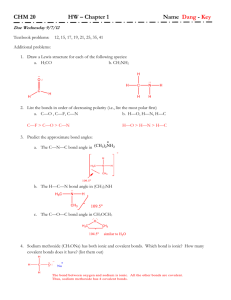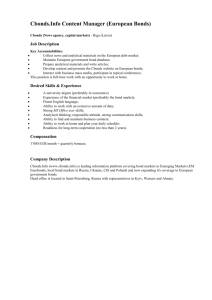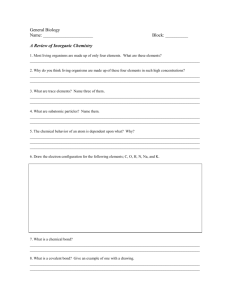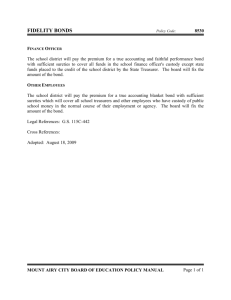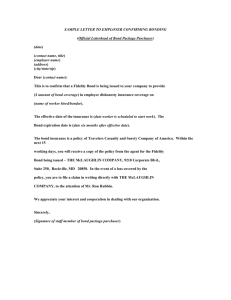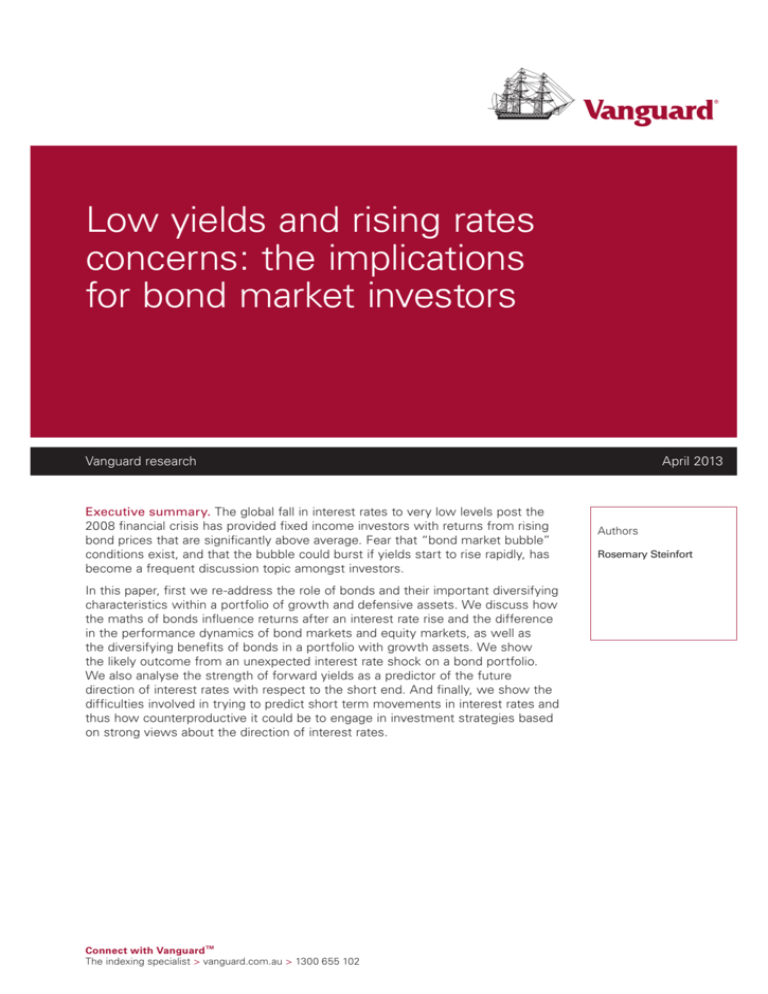
Low yields and rising rates
concerns: the implications
for bond market investors
Vanguard research
Executive summary. The global fall in interest rates to very low levels post the
2008 financial crisis has provided fixed income investors with returns from rising
bond prices that are significantly above average. Fear that “bond market bubble”
conditions exist, and that the bubble could burst if yields start to rise rapidly, has
become a frequent discussion topic amongst investors.
In this paper, first we re-address the role of bonds and their important diversifying
characteristics within a portfolio of growth and defensive assets. We discuss how
the maths of bonds influence returns after an interest rate rise and the difference
in the performance dynamics of bond markets and equity markets, as well as
the diversifying benefits of bonds in a portfolio with growth assets. We show
the likely outcome from an unexpected interest rate shock on a bond portfolio.
We also analyse the strength of forward yields as a predictor of the future
direction of interest rates with respect to the short end. And finally, we show the
difficulties involved in trying to predict short term movements in interest rates and
thus how counterproductive it could be to engage in investment strategies based
on strong views about the direction of interest rates.
Connect with Vanguard™
The indexing specialist > vanguard.com.au > 1300 655 102
April 2013
Authors
Rosemary Steinfort
The role of bonds – to provide income and
capital protection
The decline in yields across global bond markets,
driven by the 2008 financial crisis and the strong
investor preference for relatively lower risk assets,
has provided significantly above-average bond
market returns. However, concerns have arisen
that the returns from fixed income investments
may be low or negative should interest rates rise,
as a result of tighter monetary policy in response to
improving economic conditions. But, in the case of
bonds, a bubble is unlikely due to the mechanism
of the market value of a bond converging to its face
value at maturity, which acts as an anchor on bond
prices. Although, going forward, returns for bonds
will be lower than they have been, reflecting
the current interest rate environment and low
inflationary expectations on the back of weak
economic growth globally.
Despite the concerns regarding a bubble-like
situation in bond markets, the characteristics of
fixed income assets and the role that they play in
a broadly diversified portfolio of growth and
defensive assets have not changed.1 The primary
role of bonds is to be a source of diversification
to growth assets (equity); provide income (through
1 Murik, Vijay A. et al, 2012, The role of fixed income as a part of a diversified
investment strategy, The Vanguard Group
Figure 1
the receipt of bond coupons); and offer capital
stability (through the return of principal at the
maturity of a bond if no default occurs). This
means that, over the longer term, yield is the major
contributor to performance and long-run returns
from fixed income should reflect the average
level of interest rates through time.
A diversified fixed income index composed of
government bonds and investment-grade (IG)
corporate bonds, such as the UBS Composite
Bond Index demonstrates how the portfolio value
trajectory has remained robust regardless of yield
volatility and direction. During periods of yield
volatility from 1992 until recently, in which the yield
on the 10-year government bond was up about
100 basis points (bp) the average annual total return
of the UBS Composite Bond Index continued to
accumulate value. The average total returns (price
and coupon) over one, three and five years were
positive, reflecting the significant component that
bond coupons contribute to fixed income returns
(see Figure 1).
Bond maths and bond returns
Bonds are quite different from investments such
as equities due to a well-defined and certain return
stream, which responds to movements in interest
rates. While a higher yield and lower bond prices
(a capital loss) result from rising interest rates,
the opposite is true for falling interest rates.
Annual total return of the UBS Composite Bond Index over 1, 3 and 5 years,
subsequent to a rise in 10-year government bond yields of approximately 100 bp
10%
9
8
7
6
5
4
3
2
1
0
1 yr return
3 yr return
Note: The returns here represent the average return across all periods that saw a 100-basis-point rise in yields.
As with any average, some periods saw higher returns and some saw lower returns.
Source: Factset data dated 18 April 2013
2
5 yr return
A case study – the bond market in 1994
The bond market collapse of early 1994, when yields were low versus the long term average, saw yields
rise rapidly during a short period. The total return of the UBS Composite Bond Index was -6.5% for the
six months ended June 1994 as the decline in the value of bonds was greater than the coupon income.
For the subsequent six months the return was around 1.9% and 9.8% for the first six months of 1995,
due to the receipt of coupons which contributed to the lower starting yield. During that period bonds
matured and bond issuers were able to repay the principal to the bondholder. The reinvestment earnings
became a significant contributor to returns due to the higher yield – with reinvestment of coupons and
the replacement of maturing bonds with higher yielding bonds. For the three-year period following the
1994 collapse of the bond market, total returns for the UBS Composite Bond Index were 12.7% per
annum – which is difficult to reconcile with bursting of the “bond market bubble.“
Duration measures the sensitivity of a bond’s price
to changes in interest rates (see Bennyhoff and
Zilbering’s research from 2010). Duration is used
as the common metric for evaluating risk between
two comparable fixed income investments. So,
for illustrative purposes, if interest rates increase
1 percentage point (100 bp), a bond’s (or fund’s)
value will drop by approximately the bond’s (or the
fund’s weighted average) duration. This assumes
that there is an instantaneous, parallel shift in the
yield curve, an assumption that is extremely rare
historically (Davis et al., 2010). But the factors
driving increases in near-term rates (monetary
policy implemented by the Reserve Bank of
Australia (RBA)) and long-term rates (inflation
expectations) are quite different.
Figure 2
An example of a significant, unexpected move in
interest rates occurred in the 1990s, (see text box,
“A case study – the bond market in 1994”) and
although the one-off impact was negative for a total
return investor, the new much higher yield was of
perhaps greater importance. Following the initial
pain when there was a jump in interest rates, that
same investor would expect a strong return going
forward based on the higher yield, all else being
equal (as we saw in subsequent years after 1994).
And at some point following the initial large negative
bond market return, the diversified bond investor
would be breaking even, simply by reinvesting
interest distributions.
Distribution of total returns and the total risk fixed income and equity from 1989 – 2012
120
Frequency of returns
100
Total annualised risk:
Equities 13%
Bonds 4%
80
60
40
20
0
-13%
-11%
-9%
-7%
-5%
-3%
Equities
-1%
1%
3%
5%
7%
9%
11%
13%
Bonds
Source: Bloomberg, data dated February 2013
3
Total returns, income, and the search for yield
Vanguard believes it is important for investors to view their portfolios from a total return perspective,
rather than simply in terms of potential income (i.e., the yield to maturity on a bond fund, or the dividend
yield on an equity fund). An investor looking at total return will be concerned with capital gains and losses
as well as with the income derived from bond interest and equity dividends. Past Vanguard research has
highlighted the importance of understanding total return and the risks that can accompany a narrow
focus on income.
Investors who increase their allocation to higher-yielding bonds or dividend-paying equities in an attempt
to meet spending needs, based on income alone, should be aware that their portfolio volatility will likely
increase as a result. So while an allocation to bonds may have the prospect of providing below-average
total returns going forward, the volatility-dampening properties of bonds should be carefully taken into
consideration when developing a sound investment strategy.
Performance dynamics of fixed income and
equity indexes
An often misunderstood aspect of fixed income
investing through a highly diversified structure such
as a composite index is that the nature of returns
is very different from an equity index, in both
normal and stressed market conditions. An important
aspect of the fixed nature of the asset cash flows
and capital structure ranking, is that returns are more
narrowly distributed than the returns for an equity
index. Figure 2 shows the distribution of monthly
total returns for equities (represented by the S&P/
ASX 300 and ASX All Ordinaries for periods prior to
Figure 3
1 April 2000) and bonds (represented by the UBS
Composite Bond Index) since 31 December 1989
as well the total annualised risk over the period.
The diagram shows that the returns for fixed income
occur in a tighter range and provide less variability
borne out by the lower total risk of 4% compared
to equities’ total risk of 13%.
Investing in a diversified bond fund lowers the risk
of loss due to default and has lower volatility than
a portfolio with a 100% weighting in equities.
Furthermore, investing in a portfolio that has a
50/50 weighting to equities and bonds provides
long-term returns that are likely to be higher than
Returns and volatility of different weightings to equities and fixed income over twenty years
– initial investment of $10,000
$80,000
70,000
Return Volatility
60,000
50,000
Equitiy
9.7%
50/50
8.9%
13.3%
7.0%
Fixed income
7.5%
3.9%
40,000
30,000
20,000
10,000
0
1992
1994
1996
100% Australian fixed income
1998
2000
2002
2004
2006
50% Australian equities + 50% Australian fixed income
2008
2012
100% Australian equities
Note: This is not a recommendation for an asset allocation strategy but for illustrative purposes only
Source: FactSet data, dated March 2013. Equities are represented by the S&P/ASX300 and ASX All Ordinaries for periods prior to 1 April 2000
and bonds are represented by the UBS Composite Bond Index. Analysis period is 1992 to 2012
4
2010
Figure 4
Impact of unexpected interest rate changes on the performance of the UBS Composite Bond Index
24%
22
20
18
16
14
12
10
8
6
4
2
0
-2
-4
-6
-8
1 day
1 yr
2 yrs
3yrs
4yrs
5yrs
Yield curve shift
50bp
100bp
200bp
Note: This is a hypothetical case study of a rise in yields
Sources: UBS data as at 31 December 2012, downloaded February 2013
a 100% weighting in fixed income and, although
total risk is higher than in a fixed income portfolio,
it is more moderate over the long term than a
portfolio with a 100% weighting in equities
(Figure 3).
The impact of unexpected interest rate
shocks on a portfolio of bonds
An important factor that has influenced bond
markets has been the increase in transparency
by central banks and the introduction of inflation
targeting policy.2 This has reduced the likelihood
of unexpected, potentially large interest rate
adjustments due to reducing inflationary
2 RBA, 2009, The Australian Experience with Inflation Targeting, http://www.rba.gov.
au/speeches/2009/sp-ag-150509.html downloaded 13 February 2013
expectations, by maintaining inflation within
the average band.
Historically, Australia had periods of high inflation with
spikes at different times but since inflation targets
were introduced in the 1990s the inflation rate has
averaged 2.7%, as interest rates adjustments have
influenced inflationary expectations.
Even if there is a future spike in inflation (unlikely
due to the RBA’s use of monetary policy), the
nature of fixed income returns means that there
would be short-term negative returns, arising from
the decline in value of existing assets due to the
increase in yield – but for a longer-term investor,
this gives way to longer-term positive returns from
bond coupons and pull-to-par effect (see text box
“Pull-to-par”).
Pull-to-par
Pull-to-par effect is where the market price of a bond converges to the face or par value, as the bond
moves closer to its maturity date, assuming the bond does not default. There is also the amortisation
impact with a rise in yield causing a price fall (all else being equal) but the investor is compensated for
the fall in price in the form of relatively higher coupons. Bond funds also receive the benefits of pull-topar as the principals from maturing securities are rolled into new issues which are typically priced at or
close to par. The proviso is that by the time that securities in a bond fund mature, the par yield will have
moved to prevailing market levels, which are likely to be different from those for maturing securities. So
although the pull-to-par effect still holds for bond funds, it applies at different points in time as existing
securities mature and new issues are added to the portfolio.
5
In the case of a rise in value of existing assets from
a decrease in yield, the immediate one-off positive
impact from the bond’s price rise is greater but, over
the longer term, the prevailing yield will be lower and
will have a less positive impact on total return.
An analysis of the impact of a hypothetical
unexpected uniform interest rate increase on
the yield to maturity of the securities in the UBS
Composite Bond Index demonstrates the effect
on total return with the fall in price and the positive
impact from the higher coupon. Figure 4 shows
the immediate impact to the index from a yield
increase of 50, 100 or 200 bp and how the
cumulative return changes over one, two, and up
to five years, assuming no further yield change.3
The immediate impact shows returns will fall by
2.0%, 3.0% and 7.5% respectively (predominantly
due to the fall in the price of the bond), for each
shift up the yield curve of 50, 100 and 200 bp,
reflecting the duration and convexity of the index.
This loss will only affect investors’ returns if the
security is sold and the loss realised. If the
investment is held for another year, only the 200
bp move would have resulted in a negative return
of 2.5% and holding the investment for two years,
would result in all returns being positive. For five
years, cumulative total returns are 19.5%, 20.1%
and 21.3%, respectively for the 50, 100 and 200 bp
increases in interest rates.
3 Assuming bonds that mature are not replaced, especially after three years as more
bonds mature
Figure 5
If we break down the performance of a bond into
yield and price, we can distinguish that over the
longer term, the coupon (income) will have the
greatest impact on returns but there is also the
guaranteed return of the principal. The remaining
coupons and the principal repayment at maturity,
assuming no default, provide a natural ceiling to
the price of the bond. So in reality a bond market
bubble in the same context as an equity market
bubble is not possible for bonds.
The implications for bond market investors
The bond market’s expectations for the future
shape of the yield curve may seem reasonable
but, as history has shown, rates are likely to evolve
differently from what is expected today. The
forward yield curve – as with other interest rate
forecasts – may be a poor predictor of actual future
rates (see Figure 5 which shows short term
interest rates versus the forward rates).4 So,
considering the current market conditions and the
lessons learnt post the 2008 crisis, how should
bond investors think about the risks to current
market rate expectations?
Investors in bonds must be aware that implementing
bond strategies, involving shortening duration or
investing solely in riskier bond instruments, can
expose them to unintended yield curve or market
risks, while potentially depriving them of a higher
4 For a more detailed and technical discussion of interest rate predictability please
see Ilmanen (1996) and Davis and Aliaga-Díaz (2007), as well as the citations therein.
Short term rates versus market expectations
9.0
Bank Bill rates - 30 day (%)
8.0
Actual short term rates
7.0
Forward rates
6.0
5.0
4.0
3.0
2.0
1.0
0
2000
2002
2004
2006
Source: Reserve Bank of Australia, downloaded 14 April 2013, with Vanguard analysis
6
2008
2010
2012
2014
Mitigating bond risk by moving into cash
We recognise that bond investors, facing the prospect of rising rates, are naturally inclined to either
shorten duration or move into cash. There are several potential concerns with such a strategy. Davis et
al. (2010) note the risks inherent in such a strategy if the yield curve experiences a “bear flattening,”
meaning short-term rates rise, while longer-term rates remain anchored. In addition, investors who shift
from bonds to cash will realise an opportunity cost in the form of lower yield while they wait for the
anticipated rise in rates. The longer the wait, the greater the yield give-up. Finally, because cash has
historically offered a low real return, investors using such a strategy would then need to correctly time
their exit. This is because, historically, cash investments have tended to underperform both equities and
bonds following a given rise in interest rates in both nominal and real returns.
future income stream. Different scenarios are
possible going forward with respect to the direction
and timing of interest rate movements. However,
the uncertainty surrounding the future direction
of economic indicators with respect to correctly
forecasting what happens and when, is a powerful
reminder that focusing on interest rate moves and
short-term changes in bond prices can be
counterproductive.
The implication for bond market investors with
respect to uncertainty supports fixed income
diversification – as the historical variable
performance (see Figure 6) of various segments
of the bond market (which are constituents of
Figure 6
the UBS Composite Bond Index) reinforces the
benefits of a broadly diversified fixed income
portfolio regardless of the future direction of
interest rates.
The time horizon of the investor may also need
to be considered, for example if the investor has
a short-term investment period then a diversified
bond fund may not be the best investment option.
However, investors should be aware of the risks
of staying in cash or shorter duration bonds due
to the opportunity cost from lower yields (see
the text box, “Mitigating bond risk by moving
into cash”).
Annual returns for different segments of the bond market – constituents of the
UBS Composite Bond Index, data for years ending December 2004 – 2012
25%
20
15
10
5
0
2004
2005
2006
2007
2008
UBS Composite Bond Index 0+YR – Total Return
UBS Semi Govt Index 0+YR – Total Return
UBS Supra/Sov Index 0+YR – Total Return*
2009
2010
2011
2012
UBS Credit Index 0+YR – Total Return
UBS Treasury Index 0+YR – Total Return
*No returns available until 2006
Source: Factset data dated 22 April 2013
7
Over the long term, interest income – and the
reinvestment of that income – accounts for the
largest portion of total returns for many bond
funds. The impact of price fluctuations can be
more than offset by staying invested and
reinvesting income, even if the future is similar
to the rising-rate environment seen at different
times in history.
As seen during the high interest rate environment
of 1994, the average yield nearly doubled, but after
a three-year period the annualised total return from
a diversified bond index such as UBS Composite
Bond Index was nearly 13%, which is certainly not
unattractive. Subsequent to the peak in interest
rates in 1994, lower interest rates continued for
the next few decades as inflation expectations
declined, resulting in even higher bond returns
over that period.
Conclusion – how an investor should
respond to concerns about rising
interest rates
The investors’ response to concerns about higher
interest rates may depend on their investment time
horizon, but in most cases the following will apply:
• A majority of diversified, long-term investors
should not view a bond bear market with the
same level of apprehension as an equity bear
market. As we saw in 1994, despite a massive
rise in yields, a diversified fixed income
benchmark such as the UBS Composite Bond
Index still had a strong return over a three-year
period, and even over a shorter time the return
was still relatively attractive. A bubble-like
scenario as we have seen in equity markets
(“the tech crash”) is not really possible in the
bond market due to the guaranteed and fixed
future cash flow.
• A decline in bond prices, as the result of a rise
in yield, in most cases will be offset with higher
nominal yields and potentially higher subsequent
nominal returns; and
• A balanced diversified portfolio, which invests
in defensive and growth assets, will produce an
attractive risk-return outcome during any interest
rate scenario.
8
References
ASFA, 2012, Developing Australia’s fixed interest
markets, viewed 19 February 2013
Bennyhoff, Donald G., and Yan Zilbering, 2010.
Distinguishing Duration from Convexity.
The Vanguard Group
Davis, Joseph H., Roger Aliaga-Díaz, and Andrew
Patterson, Asset allocation in a low-yield and volatile
environment, The Vanguard Group, 2011
Davis, Joseph H., 2010, Should you be aware of
the bond market bubble?, commentary on
www.vanguard.com
Davis, Joseph, Roger Aliaga-Díaz, Donald G.
Bennyhoff, Andrew J. Patterson and Yan Zilbering,
2010, Deficits, the Fed, and rising interest rates:
Implications and considerations for bond investors,
The Vanguard Group
Davis, Joseph H., and Roger Aliaga-Díaz, 2007.
Real-time forecasting of U.S. bond yields and their
excess returns. Working paper, Social Science
Research Network.
Ennis, Richard M., and Michael D. Sebastian, 2002.
The Small-Cap Alpha Myth, Journal of Portfolio
Management 28(3): 11–16
Federal Reserve Bank of San Francisco, 2011,
Opening the Temple, viewed 15 February 2013
Federal Reserve Bank of San Francisco Simple and
Robust Rules for Monetary Policy, viewed 15
February 2013 http://www.frbsf.org/publications/
economics/papers/2010/wp10-10bk.pdf
Ilmanen, Antti, 1996. Market’s Rate Expectations
and Forward Rates. Journal of Fixed Income
(Vol. 6, no. 2, September): 8–22
International Monetary Fund, 2007, Are Debt Crises
Adequately Defined? Viewed 15 February 2013
International Monetary Fund: Currency Composition
of Official Foreign Exchange Reserve, downloaded
8 April 2012
Philips, Christopher, Francis Kinniery, and David
Walker, 2010, Risk of loss: Should investors shift
from bonds because of the prospect of rising rates?
The Vanguard Group
Malkiel, Burton G., and Aleksander Radisich, 2001,
The Growth of Index Funds and the Pricing of
Equity Securities, Journal of Portfolio Management
27(2):9–21.
Murik, Vijay A et al, 2012, The role of fixed income
as apart of a diversified investment strategy,
The Vanguard Group
RBA, 2009, The Australian Experience with Inflation
Targeting, downloaded 13 February 2013 http://
www.rba.gov.au/speeches/2009/sp-ag-150509.html
RBA, 2001, Monetary Policy: The End of History?
viewed 15 January 2013
RBA, Research Discussion Paper, Coppel, Jonathan
and Ellis Connolly, 2003, What do financial markets
tell us about monetary policy transparency?
Downloaded 5 March 2013 http://www.rba.gov.au/
publications/rdp/2003/2003-05.html
9
Connect with Vanguard®
The indexing specialist > vanguard.com.au > 1300 655 102
This paper includes general information and is intended to assist you.
Vanguard Investments Australia Ltd (ABN 72 072 881 086 / AFS Licence
227263) is the product issuer. We have not taken your circumstances into
account when preparing the information so it may not be applicable to your
circumstances. You should consider your circumstances and our Product
Disclosure Statements (“PDSs”) before making any investment decision.
You can access our PDSs at vanguard.com.au or by calling 1300 655 101.
Past performance is not an indication of future performance.
This publication was prepared in good faith and we accept no liability for
any errors or omissions.
Vanguard pays a fee for subscription data.
© 2013 Vanguard Investments Australia Ltd (ABN 72 072 881 086 /
AFS Licence 227263). All rights reserved.
10
“Vanguard”, “Vanguard Investments”,
“LifeStrategy” and the ship logo are the
trademarks of The Vanguard Group, Inc.
globalequitiesREPORT 042013



